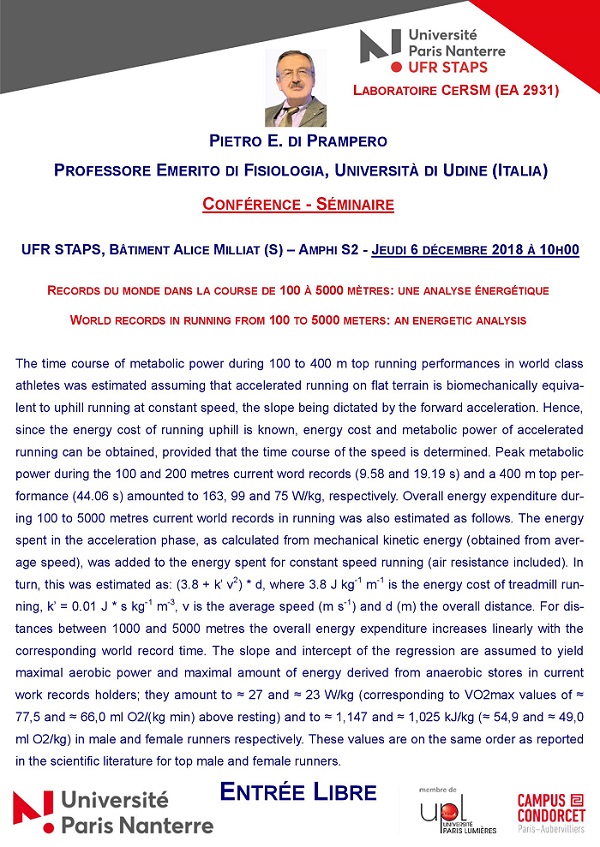Version française / Actualités / Séminaires et colloques
- Libellé inconnu,
Séminaire CERSM : Records du monde dans la course de 100 à 5000 mètres: une analyse énergétique
Publié le 27 novembre 2018
–
Mis à jour le 27 novembre 2018

Conférence présentée par Monsieur Pietro E. di Prampero, professeur émérite de physiologie à l'université di Udine - UFR STAPS et le laboratoire CeRSM EA 2931
Date(s)
le 6 décembre 2018
10h00
Lieu(x)
Bâtiment Alice Milliat (S)
Amphi S2
World records in running from 100 to 5000 meters: an energetic analysis
The time course of metabolic power during 100 to 400 m top running performances in world class athletes was estimated assuming that accelerated running on flat terrain is biomechanically equivalent to uphill running at constant speed, the slope being dictated by the forward acceleration. Hence, since the energy cost of running uphill is known, energy cost and metabolic power of accelerated running can be obtained, provided that the time course of the speed is determined. Peak metabolic power during the 100 and 200 metres current word records (9.58 and 19.19 s) and a 400 m top performance (44.06 s) amounted to 163, 99 and 75 W/kg, respectively. Overall energy expenditure during 100 to 5000 metres current world records in running was also estimated as follows. The energy spent in the acceleration phase, as calculated from mechanical kinetic energy (obtained from average speed), was added to the energy spent for constant speed running (air resistance included). In turn, this was estimated as: (3.8 + k’ v2) * d, where 3.8 J kg-1 m-1 is the energy cost of treadmill running, k’ = 0.01 J * s kg-1 m-3, v is the average speed (m s-1) and d (m) the overall distance. For distances between 1000 and 5000 metres the overall energy expenditure increases linearly with the corresponding world record time. The slope and intercept of the regression are assumed to yield maximal aerobic power and maximal amount of energy derived from anaerobic stores in current work records holders; they amount to ≈ 27 and ≈ 23 W/kg (corresponding to VO2max values of ≈ 77,5 and ≈ 66,0 ml O2/(kg min) above resting) and to ≈ 1,147 and ≈ 1,025 kJ/kg (≈ 54,9 and ≈ 49,0 ml O2/kg) in male and female runners respectively. These values are on the same order as reported in the scientific literature for top male and female runners.
Mis à jour le 27 novembre 2018








